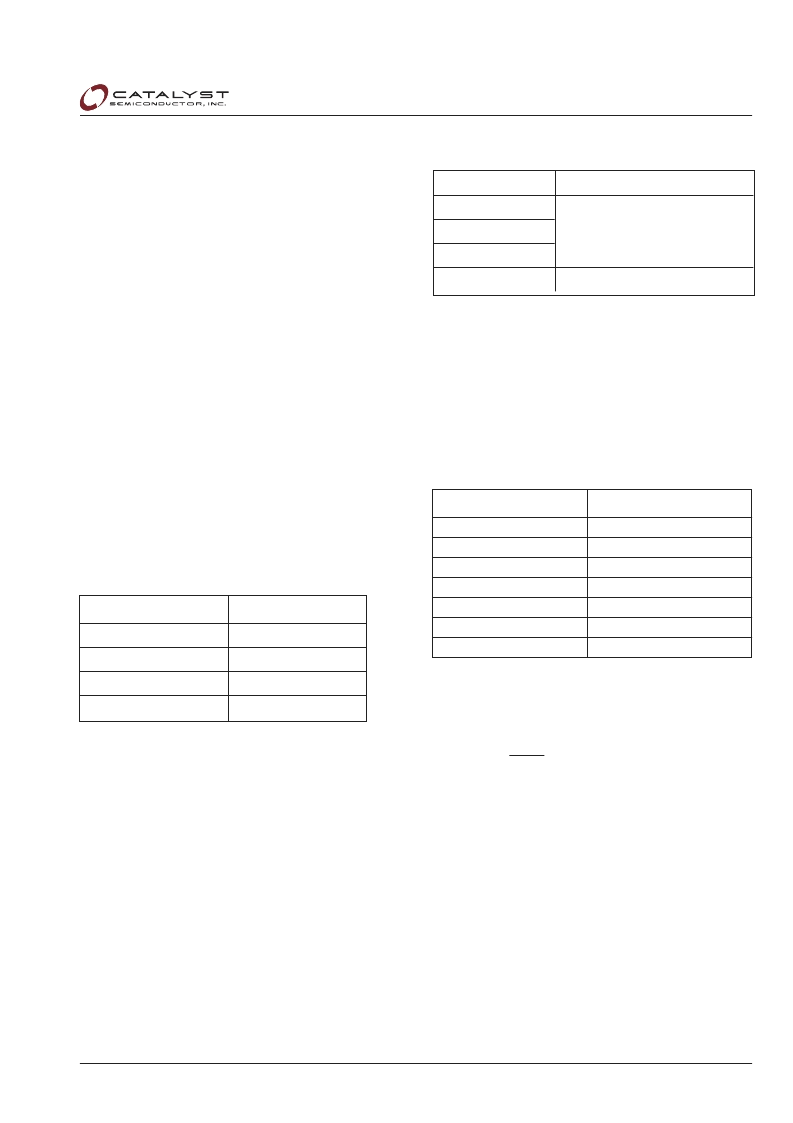- 您現(xiàn)在的位置:買賣IC網(wǎng) > PDF目錄369655 > CAT37TDI-TE7 CMOS White LED Driver Boost Converter PDF資料下載
參數(shù)資料
| 型號(hào): | CAT37TDI-TE7 |
| 元件分類: | LED驅(qū)動(dòng)器 |
| 英文描述: | CMOS White LED Driver Boost Converter |
| 中文描述: | 的CMOS白光LED驅(qū)動(dòng)器升壓轉(zhuǎn)換器 |
| 文件頁數(shù): | 7/12頁 |
| 文件大小: | 566K |
| 代理商: | CAT37TDI-TE7 |

CAT37
7
Doc No. 5005, Rev. S
2005 by Catalyst Semiconductor, Inc.
Characteristics subject to change without notice
DIODE SELECTION
Schottky diodes, with their low forward voltage drop and
fast switching speed, are the ideal choice for high
efficiency applications. Table 2 shows several different
Schottky diodes that work well with the CAT37. Make
sure that the diode has a voltage rating greater than the
output voltage. The diode conducts current only when
the power switch is turned off (typically less than one-
third the time), so a 0.4A or 0.5A diode will be sufficient
for most designs.
APPLICATION INFORMATION
CAPACITOR SELECTION
Low ESR (equivalent series resistance) capacitors should
be used at the output to minimize the output ripple
voltage. The low ESR and small package options
available with multilayer ceramic capacitors make them
excellent choices. The X5R and X7R capacitor types are
preferred because they retain their capacitance over
wider voltage and temperature ranges than the Y5V or
Z5U types. A 1.0
μ
F output capacitor is recommended
for most applications.
The voltage rating of the output capacitor C2 depends on
the number of LEDs driven in the series. A 16 V ceramic
capacitor is recommended when driving 3 or 4 LEDs.
Low profile ceramic capacitors with a 1mm maximum
height/thickness are available for designs height
requirements. Ceramic capacitors also make a good
choice for the input capacitor, which should be mounted
as close as possible to the CAT37. A 1
μ
F or 4.7
μ
F
input capacitor is recommended. Table 1 shows a list of
several ceramic capacitor manufacturers. Consult the
manufacturers for detailed information as new products
and package options are introduced regularly.
Table 1. Ceramic Capacitor Manufacturers
Supplier
Web
Taiyo Yuden
www.t-yuden.com
Murata
www.murata.com
Kemet
www.kemet.com
AVX
www.avxcorp.com
LED CURRENT PROGRAMMING
The LED current is programmed with a single resistor
connected to the FB pin. The FB pin is internally regulated
to 95 mV, which sets the current flowing through R1 and
the LEDs as equal to
0.095/R1.
For the best accuracy, a 1% or better resistor is
recommended. Table 3 shows several typical 1% R1
values.
Table 3. R1 Resistor Values
I
LED
(mA)
40
30
20
15
12
10
5
R1 (
)
2.37
3.16
4.75
6.34
7.87
9.53
19.1
Table 2. Schottky Diode Suppliers
Part
Supplier
MBR0520
ON Semiconductor
MBR0530
www.onsemi.com
MBR0540
800.282.9855
ZHCS400
Zetex
For other LED current values, use the following equa-
tion to choose R1.
R1=0.095
I
LED
Most white LEDs are driven at maximum currents of
15mA to 20mA. Some higher power designs will use two
parallel strings of LEDs for greater light output, resulting
in 30mA to 40mA (two strings of 15mA to 20mA) flowing
through the R1 resistor.
相關(guān)PDF資料 |
PDF描述 |
|---|---|
| CAT4004 | 4-Channel Constant Current LED Driver with EZDi TM |
| CAT4004VP2-T3 | 4-Channel Constant Current LED Driver with EZDi TM |
| CAT4238 | High Efficiency 10 LED Boost Converter |
| CAT4238TD-GT3 | High Efficiency 10 LED Boost Converter |
| CAT5241WI-10 | Quad Digitally Programmable Potentiometers (DPP⑩) with 64 Taps and 2-wire Interface |
相關(guān)代理商/技術(shù)參數(shù) |
參數(shù)描述 |
|---|---|
| CAT-38-PP | 功能描述:INSTALL TOOL ORANGE FOR SHR SER RoHS:是 類別:工具 >> 螺線形繞線,伸縮套管 系列:- 標(biāo)準(zhǔn)包裝:1 系列:Slit-N-Wrap® |
| CAT-38-PP-BU | 功能描述:INSTALL TOOL ORANGE FOR SHR SER RoHS:是 類別:工具 >> 螺線形繞線,伸縮套管 系列:- 標(biāo)準(zhǔn)包裝:1 系列:Slit-N-Wrap® |
| CAT4002A | 制造商:ONSEMI 制造商全稱:ON Semiconductor 功能描述:Constant Current LED Driver with 32 Dimming Levels and Rset |
| CAT4002A_10 | 制造商:ONSEMI 制造商全稱:ON Semiconductor 功能描述:Constant Current LED Driver with 32 Dimming Levels and Rset |
| CAT4002ASD-GT3 | 功能描述:LED照明驅(qū)動(dòng)器 LED DR 2 CH EZ DIM I/F RoHS:否 制造商:STMicroelectronics 輸入電壓:11.5 V to 23 V 工作頻率: 最大電源電流:1.7 mA 輸出電流: 最大工作溫度: 安裝風(fēng)格:SMD/SMT 封裝 / 箱體:SO-16N |
發(fā)布緊急采購,3分鐘左右您將得到回復(fù)。